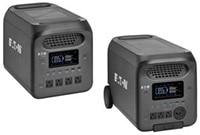可攜式鋰離子電源站
Tripp Lite by Eaton 鋰離子電源站是適用於室內或戶外的零排放替代方案,可取代汽油發電機
 在無可用市電時,Tripp Lite by Eaton 可攜式鋰離子電源站提供安靜且零排放的解決方案。可充電磷酸鐵鋰 (LiFePO4) 電池供電時不會產生煙霧或噪音,適合在室內和戶外防水區域使用。
在無可用市電時,Tripp Lite by Eaton 可攜式鋰離子電源站提供安靜且零排放的解決方案。可充電磷酸鐵鋰 (LiFePO4) 電池供電時不會產生煙霧或噪音,適合在室內和戶外防水區域使用。
這些裝置採用可攜式設計,並內建把手。GC3000L 型號還配備輪子及伸縮把手,方便搬運,並隨附防滑手套。這些電源站可用於工地、行動部署/工作現場、車隊卡車、野外醫療站、露營地與家庭,只要具備防護遮蔽即可使用。1,800 W 與 3,000 W 兩種型號皆配備直覺化 LCD 面板、多種輸出連接,以及多樣化的充電選項。它們適用於無法使用市電,且不宜或不能安全使用汽油/柴油發電機的場所。
- LiFePO4 電池可提供高達 1,800 W (GC1800L) 或 3,000 W (GC3000L)
- 過載、過充、短路保護
- GC1800L 電池支援 3,000 次充電/放電循環
- GC3000L 電池支援 4,000 次充電/放電循環
- 延長運作時間:GC3000L 可支援多達六組擴充電池組 (BPGC2500L,另售)
- 通風口有助於防止過熱
- 便利的裝置供電方式:AC 插座、USB-C 連接埠、USB-A 連接埠、快速充電 USB-A 連接埠
- DC 輸出選項包括車用充電器 (點菸器) 輸出、DC5521 插頭、Anderson 連接器 (僅限 GC3000L)
- 充電選項:
- 交流電:透過牆上插座供電 (隨附充電線)
- 直流電:透過車輛點菸器配接器 (CLA)
- 直流電:透過可折疊光電 (PV) 太陽能板 (SC-G0)
- 容易使用的 LCD 顯示器可顯示輸入與輸出功率,以及電池狀態 (剩餘電量百分比、剩餘充/放電時間)。同時亦提供與溫度相關的問題及其他故障的警告
- 工地
- 行動部署/工作現場
- 車隊卡車
- 野外醫療站
- 露營地
- 家庭 (需具備防護遮蔽)
- 任何具備防護遮蔽、無法使用市電,且不宜或不能安全使用汽油/柴油發電機的場所










